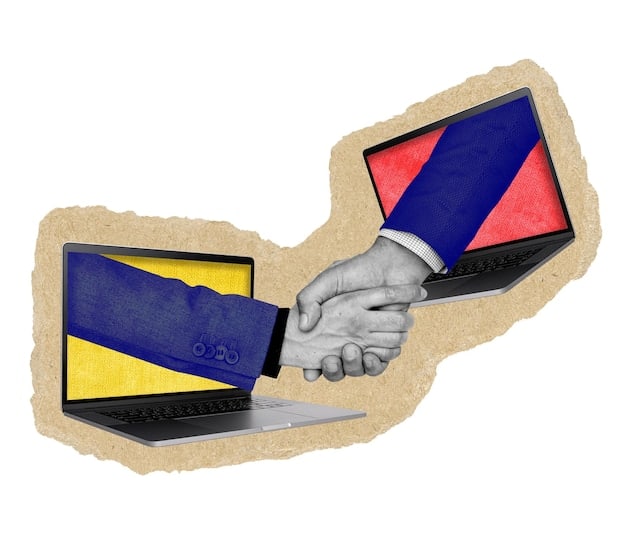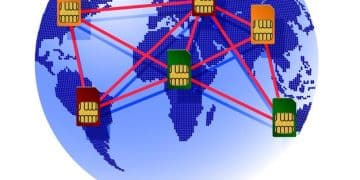Revolutionizing Supply Chains: The Impact of Blockchain in the US

Blockchain technology is transforming supply chain management in the US by enhancing transparency, security, and efficiency across various industries.
The integration of blockchain technology on supply chain management in the US is no longer a futuristic concept but a tangible reality, reshaping how goods and information flow from origin to consumer. This transformative technology promises to address long-standing challenges in supply chainVisibility, security, and efficiency, offering a new paradigm for businesses operating within the US and globally.
Understanding Blockchain Technology and Its Potential
Blockchain technology, initially known for its role in cryptocurrencies, has far broader applications, particularly in supply chain management. Its ability to create a transparent, secure, and immutable record of transactions makes it an ideal solution for addressing many of the inefficiencies and vulnerabilities that plague traditional supply chains.
What is Blockchain?
At its core, blockchain is a distributed ledger technology (DLT) that records transactions across many computers. This decentralized structure makes it virtually impossible to tamper with the data, ensuring high levels of security and integrity.
Key Benefits of Blockchain
Blockchain offers several key benefits that are particularly relevant to supply chain management, including enhanced transparency, improved security, increased efficiency, and reduced costs. Here are some benefits from it:
- Transparency: All participants in the supply chain can access the same, immutable record of transactions, providing end-to-end visibility.
- Security: The decentralized nature of blockchain makes it highly resistant to fraud and hacking.
- Efficiency: Automation through smart contracts can streamline processes and reduce delays.
- Cost Reduction: By eliminating intermediaries and reducing errors, blockchain can lower operational costs.
These advantages are driving increased interest and adoption of blockchain solutions across various industries in the United States.
Enhancing Transparency in US Supply Chains with Blockchain
One of the most significant impacts of blockchain on supply chain management is the enhancement of transparency. Traditional supply chains often suffer from a lack of visibility, making it difficult to track products as they move through various stages.
Tracking and Tracing Products
Blockchain enables companies to track and trace products in real-time, from their origin to the end consumer. Every transaction, such as a change in ownership or location, is recorded on the blockchain, creating a complete and auditable history.
Improved Consumer Confidence
Enhanced transparency can significantly improve consumer confidence, as customers can verify the authenticity and origin of products. This is particularly important for industries such as food and pharmaceuticals, where safety and quality are paramount. Here are some examples of industries using Blockchain to track their products:
- Food Industry: Tracking the source and journey of food products to ensure safety and authenticity.
- Pharmaceuticals: Verifying the origin and preventing the distribution of counterfeit drugs.
- Luxury Goods: Ensuring the authenticity of high-value items to combat fraud.
By providing consumers with access to verifiable information, blockchain helps build trust and loyalty.

Improving Security and Reducing Fraud
Security is a critical concern for supply chains, as they are vulnerable to fraud, theft, and counterfeiting. Blockchain’s inherent security features make it an effective tool for mitigating these risks.
Immutable Record of Transactions
The immutable nature of blockchain ensures that once a transaction is recorded, it cannot be altered or deleted. This makes it extremely difficult for fraudulent actors to tamper with the data.
Combating Counterfeiting
Counterfeiting is a major problem for many industries, resulting in significant financial losses and potential harm to consumers. Blockchain can help combat counterfeiting by providing a secure and verifiable record of a product’s origin and ownership. It helps to confirm the authenticity and legitimacy of the goods.
Using blockchain to maintain information about the origin as well as the characteristics of the product is a powerful deterrent against fraud and counterfeiting because there is an increased effort to change information saved inside secure blocks.
Increasing Efficiency and Reducing Costs
Efficiency and cost reduction are key priorities for businesses operating in competitive markets. Blockchain can streamline supply chain processes, automate tasks, and reduce the need for intermediaries.
Smart Contracts for Automation
Smart contracts are self-executing contracts written into the blockchain. They can automate various processes, such as payments, inventory management, and customs clearance.
Reducing Delays and Errors
By automating tasks and reducing the need for manual intervention, blockchain can significantly reduce delays and errors in the supply chain. This leads to faster delivery times, lower operational costs, and improved customer satisfaction. Here are some specific examples:
- Automated Payments: Smart contracts can automatically release payments when certain conditions are met, reducing the need for manual invoice processing.
- Inventory Management: Blockchain can provide real-time visibility into inventory levels, helping companies to optimize their stock and reduce waste.
- Customs Clearance: By providing customs officials with access to verifiable information, blockchain can expedite the clearance process and reduce delays at borders.
These measures streamline supply chain operation and result in great customer service.
Challenges and Considerations for Blockchain Adoption
Despite its many benefits, there are challenges associated with the adoption of blockchain in supply chain management. Overcoming these challenges is crucial for realizing the full potential of this technology.
Scalability Issues
One of the main challenges is scalability. Some blockchain networks can only process a limited number of transactions per second, which may not be sufficient for large-scale supply chains. It is important to perform the scalability test early on when incorporating the technology.
Lack of Standardization
The lack of standardization is another obstacle. Different blockchain platforms may use different protocols and standards, making it difficult to integrate them. A collaboration is needed to reach commonly agreed and adopted standards.

Regulatory Uncertainty
Regulatory uncertainty is also a concern. The legal and regulatory landscape for blockchain is still evolving, and companies may face challenges in complying with existing laws and regulations. But it is expected once the industry moves forward, some consensus or framework will be agreed upon, hopefully.
Real-World Applications and Case Studies in the US
Several companies in the United States are already using blockchain to improve their supply chain management. These real-world applications and case studies demonstrate the transformative potential of the technology.
Walmart’s Food Safety Initiative
Walmart has implemented a blockchain-based system to track the origin and journey of its food products. This has enabled the company to quickly identify and remove contaminated products from its supply chain, improving food safety and reducing the risk of recalls.
IBM’s TradeLens Platform
IBM’s TradeLens platform uses blockchain to connect various participants in the global shipping industry, including shipping companies, ports, and customs authorities. This has improved transparency, reduced delays, and lowered costs for international trade.
There are many cases in which large international operations and brands are using the technology. Although there are initial costs of implementation, the long term benefits always overweight those costs.
Future Trends and Opportunities
The future of blockchain in supply chain management looks promising, with ongoing developments and emerging trends poised to further enhance its impact. The technology still has plenty of areas to develop.
Integration with IoT and AI
The integration of blockchain with other technologies, such as the Internet of Things (IoT) and artificial intelligence (AI), is expected to create new opportunities for optimizing supply chains. IoT devices can provide real-time data on the location and condition of products, while AI can analyze this data to identify inefficiencies and predict potential disruptions.
Expansion to New Industries
As the technology matures and becomes more accessible, it is expected to expand to new industries and applications. This includes areas such as healthcare, energy, and government.
The ability of tracking the goods and services when on the distribution lines are extremely useful. This helps to give clients an actual and honest turnaround time.
| Key Point | Brief Description |
|---|---|
| 🔎 Transparency | Enhances visibility across the supply chain. |
| 🔒 Security | Reduces fraud and counterfeiting risks. |
| ⚡ Efficiency | Automates processes and reduces delays. |
| 💸 Cost Savings | Lowers operational costs by eliminating intermediaries. |
Frequently Asked Questions
▼
Blockchain technology is a decentralized, distributed, and immutable ledger that records transactions across many computers in a network, ensuring transparency and security.
▼
Blockchain provides end-to-end visibility by recording every transaction in the supply chain, allowing all participants to track products from origin to consumer.
▼
Smart contracts are self-executing agreements written into the blockchain. They automate processes like payments and inventory management, reducing delays and errors.
▼
The main challenges include scalability issues, a lack of standardization across different platforms, and regulatory uncertainty surrounding blockchain applications.
▼
Walmart uses it for food safety, and IBM’s TradeLens connects participants in the global shipping industry, thus improving transparency and reducing costs.
Conclusion
Blockchain technology on supply chain management in the US is revolutionizing the industry by enhancing transparency, security, and efficiency. While challenges remain, the benefits of blockchain are undeniable, and its adoption is expected to continue growing as more companies recognize its transformative potential and integrate it into their operations.





